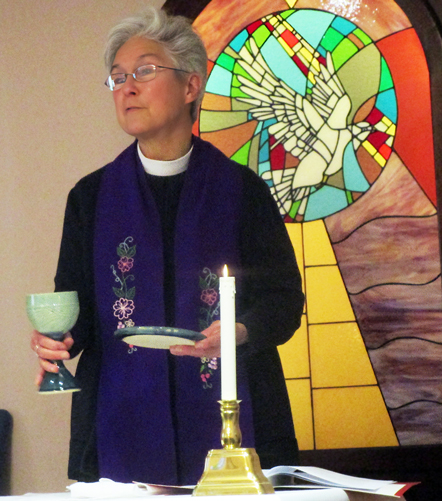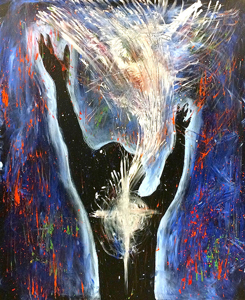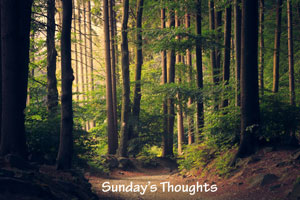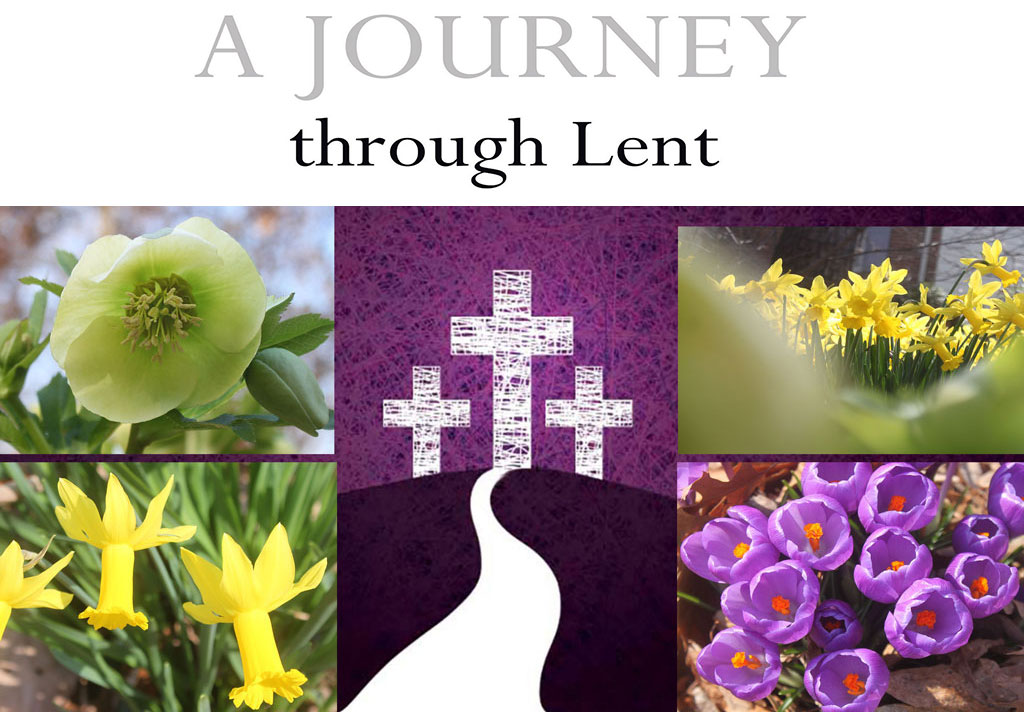SALT blog for March 17, Lent 5 – “The Hour has Come”
As with the story in John about the Temple, this portion has a different chronology. “This is Jesus’ last public teaching.
What comes next is his private goodbye to his disciples (the so-called “farewell discourse”), followed by the passion story. Tensions have been rising, and now, as Passover approaches, those tensions reach a breaking point. Jesus has just raised Lazarus from the dead, and this astonishing act — along with the widespread excitement about it — has set in motion the local authorities’ plot to kill both Jesus and Lazarus. Lazarus’ sister, Mary, has come to anoint Jesus for his death.
Here is the different chronology. “But Palm Sunday apparently had already happened. And Jesus, enacting ancient prophecies in Zechariah and the Psalms, has just entered Jerusalem on a donkey. John goes out of his way to underline that the crowds who gather along the roadsides waving palm branches are there because they had either seen Lazarus’ resurrection or heard about it. Looking at the crowds from a distance, the authorities are concerned, and whisper to each other: “Look, the world has gone after him!” (John 12:19).
“In chapter 12, “the world has gone after him,” waving branches and singing praises, and two foreign pilgrims in town for the Passover festival approach Philip and ask “to see Jesus.” In short: the word is out. Jesus’ purpose — to make the unseeable God known — is at last being fulfilled, and for this very reason, storm clouds are gathering overhead.
“Remember, the rationale behind the authorities’ plot (11:47-53) is tied directly to Jesus’ growing fame: if the people believe in Jesus in great numbers, the commotion may well attract attention — and even provoke a preemptive attack — from the Roman imperial occupiers worried about the potential for Jewish rebellion. Thus for the authorities, the more Jesus’ celebrity grows (and what’s more spectacular than raising someone from the dead?), the more the temple and the whole people are put at risk.
“Apparently sensing this tipping point when he hears that two foreign pilgrims want to meet him, Jesus declares for the first time that “the hour has come” (12:23). At several points earlier in the story, beginning with the wedding at Cana (2:4), Jesus has said that his hour has not yet arrived — but now it’s at hand. Now he will come fully into view, for all to see. Now he will be “glorified”
“What is that mean Jesus turns to an agricultural image: a grain that falls to the earth and dies, and then grows as a seed grows, bearing much nourishing fruit. In other words, being “glorified” will look like a human life freed from self-centered isolation, a generous life lived for others in community, in which both self and others flourish.
“It’s worth noting that Jesus isn’t referring only to his death here, but rather to his death, resurrection, and ascension (“And I, when I am lifted up from the earth, will draw all people to myself” (12:32)). The seed dies, yes, but then rises again and bears fruit. Jesus goes on to spell out this theme in his subsequent private farewell to his disciples, casting his ascension (i.e., his departure) as a way of making room for the disciples to do even greater things (14:12). This is why Jesus came in the first place, he declares, for this hour of his death, rising, and ascension, all for the sake of the birth of a new community. With the two Greek pilgrims, then, in this choreography of growth and nourishment we may truly “see Jesus.” God’s self-giving love for humanity is so strong that God will undergo our rejection, even to death, and then transform that rejection into new life and flourishing for the sake of “all people” (12:32).
“Jesus says all this, John reports, “to indicate the kind of death he was to die” (12:33)
“First, for John, the focus is not on the death per se but rather on what the death makes possible: the resurrection, the ascension, and not least, the bearing of “much fruit,” the birth of the church who will do even greater things (14:12)
“And second, for John, the story of Jesus’ death is shot through with a kind of sacred, subversive irony. They thought they were burying him in a grave, but actually they were planting him like a seed. They thought they were killing him to ward off the Romans, but actually they were making possible a new harvest of “much fruit,” a “lifting up” through which Jesus will “draw all people to myself” (12:32). This kind of sacred irony is itself a comfort, since it illustrates how God can work through even the worst we can do, redeeming and remaking what seems irredeemable into the service of new life. Seen through this lens, the cross is an act of subversive, redemptive divine irony: one of the worst objects on earth remade into one of the best, a sword into a ploughshare. What kind of death did Jesus die? A fruitful death, a death that subversively enabled even greater things, including a new community: men and women, young and old, Jews and Greeks.”
Chancellor’s Village sermon March 12, 2024

The local region provides clergy for Chancellor’s Village Retirement Community for their weekly Eucharist on Tuesdays. The responsibility is shared and Catherine goes about once every two months. Currently, we have 3 residents there from St. George’s so it is a good opportunity to to see them as well.
While the service is a typical Sunday service, the priests can shorten it based on those in attendance. Today, there was only one reading, the Gospel with a shortened sermon. Today we had 16 in attendance. Cookie and Johnny from St. George’s also drove up for a visit.
The sermon was Lent 4 with the Gospel reading from John 3:16. Her complete sermon is here with an excerpt below:
“Events in this life, especially at this time of life, and the things that go on in the world, do shake our faith. Suffering and evil take their ongoing toll, often randomly and unfairly. Those timeless and unanswerable questions that we ask about evil and suffering, only to come up with ..what?… challenge us. Paul says that of faith, hope and love, love is the greatest. I find that when faith and hope get shaken, then the little bit of love we can cling to, in whatever form that takes, whether it’s some reminder of God’s love for us, or the love we have for one another, or the love we share out in the world in spite of the barriers that the world raises, are the shreds of love we hold up to God, and God can use that little bit of love to weave faith and hope back into our lives.
“Love your friends who are hurting in the ways that come to you. God will do the rest, in God’s time.
So love yourself and others, as inadequate as your love can seem. For when you do any deed out of love, you have done that deed in God, and God will turn your imperfect love into the fullness of God’s own love, the love that suffers with us, carries us through, and brings us into the resurrection life that never ends.”
The Creeds Class, Part 4, March 13, 2024

“Worship the Holy Spirit” – Lance Brown
I believe in the Holy Spirit
Collect for Trinity Sunday – ” Almighty and everlasting God, you have given to us your servants grace, by the confession of a true faith, to acknowledge the glory of the eternal Trinity, and in the power of your divine Majesty to worship the Unity: Keep us steadfast in this faith and worship, and bring us at last to see you in your one and eternal glory, O Father; who with the Son and the Holy Spirit live and reign, one God, for ever and ever.” Amen
This session completes the Trinity with the Holy Spirit. There were 6 participants.
The Holy Spirit
In Hebrew and in Greek, the word spirit means “breath.” Our spirit is the breath of life that allows us to be active. God’s spirit is God’s activity throughout all the ages, beginning with creation and continuing into our lives today.
Concerts at St. Peter’s

The recent concert series began in 2013 as a way of inviting people into St Peter’s and to the town of Port Royal and to provide additional inreach for our own congregation. Our church with its excellent acoustics are attractive to both performers and audience. We have enjoyed vocal ensembles, guitarists and other string instruments. Past concerts have included:
8. The Philharmonia, Nov. 2, 2019
6. Magical Strings in Concert April 22, 2017
4. Portland Guitar Duo -April 15, 2016
3. Flamenco Concert – Sept 15, 2015
Earlier Concerts Most of the concerts in this time period were during Nell Clarke’s tenure as organist (1982-2000).
Sunday’s Thoughts – March 17, 2024

We are heading down the last lap. John is here to wrap it up with his mystical interpretation of events with a chronology that is all his own.
The word “glorify” or derivation of that appears four times in one Gospel reading. Looking it up it means to “honor” but it must mean more. John talks about glorifying his name – “Father, glorify your name.” John Piper writes about this -“When God glorifies a human being, he grants to that person the privilege of beholding his infinite beauty and becoming like him as much as a creature can”. His references are Romans and not John
“Father, glorify your name.” The idea is to approach the truth of God in direct connection to God.
For us it is dying to the things of the earth, the greed,the sin, and approach God on his own terms. We have to have a new heart and substitute God’s desires for us for the desires of this world, to focus on serving others.
John illustrates by using an object, a seed, that all know well especially in that agriculturesl society.
This meaning is enhanced by the second saying John sets in parallel: “unless a grain of wheat falls into the earth and dies, it remains just a single grain; but if it dies, it bears much fruit.” Plants go through their own death and resurrection from starting as a seed to becoming a plant and providing benefits to others in the form of nourishment. Likewise, we move from a focus on the needs of ourselves to the needs of other and this world.
The next to last sentence states, “When I am lifted up from the earth, I will draw all people to myself.”
Debie Thomas writes of the Greeks who wanted to see Jesus at the beginning of the passage and then this one. “In the end, what this week’s Gospel reading teaches me is that I don’t have to strive and strain to see Jesus. ”
She is comforted by the conclusion to which she arrives – ” He loves whether I love or not. It has taken me a long time to believe this and to trust it, but now I do: Jesus’s longing for me is the ground upon which all of my desire — however abundant or stingy — rests. He wishes to see me — to see all of us — far more urgently than we’ll ever wish to see him.”
This comforting message can help us walk the way of Holy Week with less than a heavy heart. We will be lifted up.
Sermon, March 10, 2024- Rev. Tom Hughes – “It’s part of the journey. It begins now.”
Sermon is transcribed from the video.

Good morning everybody. I want to start out by underlining some things. if you turn back to the Gospel reading that we just had – “for God so loved the world that he gave his only son so that everyone who believes in Him may not perish but have eternal life.”
That’s really the bottom line, that really is the fullness of the word of God to us because it lays out for us God’s purposes of God’s love and God’s plan for eternity.
Lenten Study, The Creeds, A Guide to Deeper Faith

When we say the Creeds (the Apostles’ Creed at baptisms and at Morning Prayer and the Nicene Creed when we celebrate the Eucharist), we are stating our belief in what the church believes, in faith, about God—that God is one being in three persons—that is, three “persons” within the one Godhead.
It’s easy to say these words without much thought because they are so familiar. And yet, they are the words that create community among Christian believers around the world, past, present, and future, the Apostles’ Creed being the most widely used of all of Christianity’s confessions of faith. These words are so important that they are permanently attached to our altar wall, along with the Ten Commandments and the Lord’s Prayer. The creeds not only bind us together in communities of faith, but these words, if taken into our hearts, can lead us to a deeper faith.
During this season of Lent, we will study these creeds, learning about how they came to be, what they mean to the Church, and we will also reflect on how they may help us grow in faith as Christians.
The study is scheduled for five Wednesday nights of Lent—Weds Feb. 21st, 28th, and March 6th, 13th, and 20th at 7PM on Zoom ID: 833 7014 5820 Passcode: 528834
Sermon, the Rev. Catherine Hicks, Chancellor’s Village, March 12, 2024
Sermon, Chancellor’s Village, March 12, 2024
For God so loved the world that he gave his only Son…
Even though we do not have crucifixes hanging in our churches, but instead the empty cross, to remind us to focus on the resurrection, this phrase about God giving his only Son, especially in the context of the quote from the Old Testament at the beginning of today’s gospel about the bronze serpent, holds before us the image of Jesus suffering and dying on the cross.
Why would this image of suffering be an image to bring love to our minds? The suffering and dying of Jesus sanctifies our own suffering and helps us to know that Jesus will go through the valleys of the shadow of death with us, and will bring us safely home, through the grave and gate of death, into an eternal life of the fullness of love in God’s presence. That is the gift of God’s love for us. God never deserts us, even when we have trouble imagining that God is present.
We live in a world of suffering and pain, our own, the pain of our friends, our family members and the news is nothing but one long report of pain. How can we, in our small ways, be present to all this pain without it killing us? Making us depressed? Or angry? Or just an ongoing dull hurt that won’t go away?
10 Ways of Understanding the Cross

This is a blog episode for the SALT project. SALT is an Emmy Award winning, not-for-profit production company dedicated to the craft of visual storytelling
It is hosted by SALT’s Matthew Myer Boulton, who’s spent twenty years teaching the Bible and theology to students at Harvard Divinity School and seminaries in New England and the Midwest,
There is a part 2 of their 7 part series “Undertanding Easter” titled “10 Ways of Understanding the Cross”
Links
1. Audio file
2. Text
Sunday’s Links, March 10, 2024
Fourth Sunday in Lent, March 10
Lector: Alice Hughes
Chalice Bearer: Alice Hughes
Altar Clean up: Andrea Pogue
Coming up!

Quick link to Feb, 2024 Lent Calendar
Quick link to March, 2024 Lent Calendar
Recent Articles, March 10, 2024
Sermon
Videos
Photos, Sunday service
Spring flowers at Church, March 10
Photos, Spring is here 1st week in March
Bulletin
God’s Garden, 10:00-11am
Lectionary, 11am service
Commentary Fourth Sunday in Lent
Visual Lectionary – Vanderbilt
Lent 4 – Mothering Sunday
10 Ways of Understanding the Cross
Thoughts on John 3:16 – God’s Offensive Love
Old Testament – Lifted Up
SALT blog for March 10
Lent began Feb. 14 (Ash Wednesday)
Lent at St. Peter’s
Lent Basics
3 key points about Ash Wed
Ash Wed. 2024, 7pm service
“Letting Go”-Diocese of Atlanta March 10
“Letting Go”-Diocese of Atlanta March 3
“Letting Go”-Diocese of Atlanta. Feb. 25
“Letting Go” series, Diocese of Atlanta
Conversation about Ash Wed
Lent Stations:Vices & Virtues
Ministries
Holy Week Workshop, March 26
Portland Guitar Duo at St. Peter’s
Help us advertise the concert!
Past Concerts at St. Peter’s
Village Harvest, Feb., 2024
Creeds class, March 6 – Jesus
Creeds class, Feb. 28- God
Creeds class, Feb. 21
Lenten Study – The Creeds
God’s Garden – Holy Week
God’s Garden – “Let the Children come to me”
God’s Garden – Making pretzels
God’s Garden- Learning the Lord’s Prayer
God’s Garden – The Alleluia Banner, Part 2
The Alleluia Banner, Part 1
Discretionary Fund donations Feb. 11
Sacred Ground, Jan., 2024
Sacred Ground, Feb., 2024
